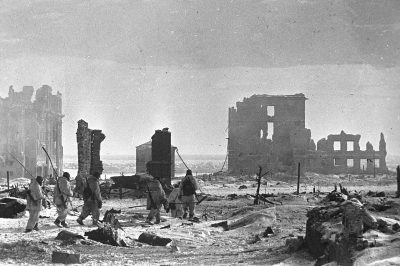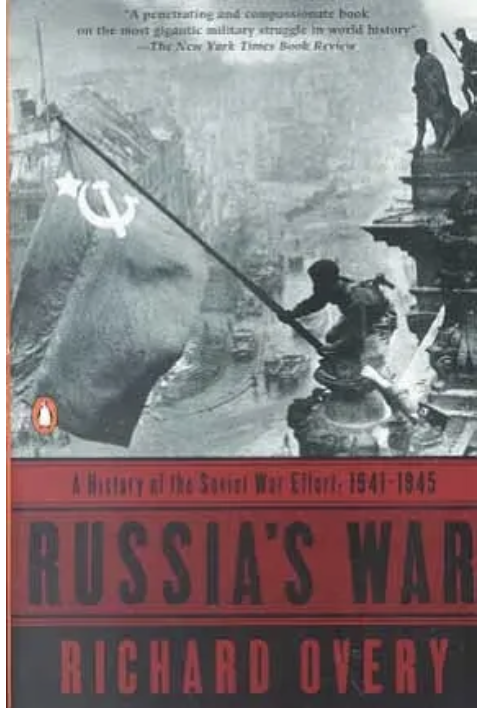History of World War II: Russia’s Defeat of Nazi Germany (1941-1945)
Review of Professor Richard Overy's Book "Russia's War"

All Global Research articles can be read in 51 languages by activating the “Translate Website” drop down menu on the top banner of our home page (Desktop version).
To receive Global Research’s Daily Newsletter (selected articles), click here.
Visit and follow us on Instagram, Twitter and Facebook. Feel free to repost and share widely Global Research articles.
***
“Little, perhaps nothing, of the experience of most Western readers and historians will have prepared them for what they will find in the history of Russia’s War’’ – Richard Overy
In 2022 we commemorate the 80th anniversary of the Battle of Stalingrad, which marked a turning point in the war against German fascism. Stalingrad represented the first nail in the coffin of the German Wehrmacht. Russia’s war against German fascism lasted four years and took an immense toll on the people of the Soviet Union with over 25 million soldiers and civilians killed. As Overy notes,
“The cost of the war dwarfed the sacrifices of any other fighting power.’’
In the West lip service is paid to the massive price paid by the Soviet people during the course of the Nazis war of annihilation on the Eastern front. Mainstream media, politicians and even school curricula will highlight the contribution made by Allied forces during the D-Day landings of 1944 but will remain curiously silent over the events and the vast battlefields of the Soviet Union.
Thankfully, there are a few Western voices that recognise, however significant the Anglo-American role in defeating Hitler’s armies was, this was fundamentally brought about by events on the Eastern Front. Hitler’s war of extermination ended by destroying its German initiators and by embedding a Soviet presence in Central and Eastern Europe for over half a century.
In this article we shall review the evidence provided by , who is one of Britain’s leading historians of the Second World War, in his book Russia’s War. This fine piece of research helps us understand more clearly than ever the enormous achievements and the horrendous price which the Soviet people paid for victory over German fascism.
Overy provides a fascinating account, revealing how the Soviet Union was able to defeat the German Wehrmacht which, in 1941, had the best trained, most well-equipped troops in the world, as well as the vast resources of a subjugated Europe at its disposal.
 It is worth recalling that at the outset of the German invasion of the USSR most governments expected Hitler’s forces to rapidly triumph over the Red Army. After the German invasion was launched American Secretary of State Henry Stimson informed President Roosevelt that the unanimous opinion of the US Chiefs of Staff was that:”Germany will be thoroughly occupied in beating Russia for a minimum of a month and possible maximum of three months.’’
It is worth recalling that at the outset of the German invasion of the USSR most governments expected Hitler’s forces to rapidly triumph over the Red Army. After the German invasion was launched American Secretary of State Henry Stimson informed President Roosevelt that the unanimous opinion of the US Chiefs of Staff was that:”Germany will be thoroughly occupied in beating Russia for a minimum of a month and possible maximum of three months.’’
Richard Overy starts with a brief description of the development of the Soviet Red Army from the October Revolution of 1917 to the highly damaging purges of the late 1930s, when the Red Army leadership was decimated by waves of arrests and executions. Estimates vary, but there is no doubt that tens of thousands of officers were executed or sent into internal exile. This had the impact of greatly weakening the effectiveness of the Red Army as a fighting force. It greatly encouraged Hitler in his decision to prepare for a full-scale invasion of the Soviet Union and enabled him to feel secure about his planned attack on France in 1940.
The author describes in a dramatic manner, the disaster which befell the Red Army during the year which followed the German invasion of 1941, when it lost 6 million soldiers to the Nazi onslaught.
As Overy reveals, the Red Army defeats of this period, which brought the German army to the gates of Moscow, can be largely put down to the incompetent military leadership of Stalin who ignored repeated warnings of the impending German invasion. His interference in the work of Red Army commanders during 1941 only served to turn Russian retreats into full-scale military disasters. Professor Overy also gives credit to the tactical brilliance of German military commanders, whose mastery of rapid mechanised warfare was unsurpassed at that time.
During the winter of 1941-42, when the Wehrmacht was laying siege to both Moscow and Leningrad, the Soviet Union appeared close to defeat. Yet, by the spring of 1943 the balance of forces on the Eastern Front been decisively transformed in favour of the Red Army. Richard Overy puts this down to several interlinked processes.
The Russian economy was completely reorganised during the winter of 1941-42 as German troops pressed 500 miles into Soviet territory. Thousands of factories were dismantled and moved to the Urals and Western Siberia. The entire population was mobilised on a vast scale into war production and the armed forces, that were made up of the Red Army and the partisan units behind German lines.
Overy pays tribute here to the critical role played by the state owned planned economy in the successes of the Soviet armed forces. Despite the loss of most of its how industrialised western regions, the Soviet planned economy displayed a great flexibility and organisational power that enabled it to out-produce the vast German economy. By 1943 the Soviet Union was out-producing Germany in the critical areas of aircraft, tank and artillery production.
The other factor following the massive defeats 1941 and 1942, was that the Stalinist bureaucracy which governed the Soviet Union was forced to ease its iron grip on Soviet society. As Overy notes: “The emergency freed many Soviet officials, managers and soldiers from an atmosphere of passivity and fear of responsibility.’’
On both the military and home fronts, this led to a period of ‘spontaneous de-Stalinisation’, which unleashed the long suppressed initiative and creativity of the Soviet people at all levels, ranging from Red Army generals and factory workers. This led to a great improvement in the morale and efficiency of the armed forces and the military economy, which were temporarily freed from the dead weight of bureaucratic control.
As Overy points out, despite the significance of the Anglo-American role on the Western front, it was events on the Eastern Front, which broke the back of the German war machine. Over 80% of German battle casualties occurred on the Eastern Front where the overwhelming weight of the Wehrmacht was concentrated. In June 1944 the Wehrmacht had 228 divisions facing the Red Army and only 58 divisions facing the Western allies.
The Nazi leadership of Germany never expected the Soviet Union to recover its economic/military strength following the devastating losses of 1941-1942. Nor did it expect the Red Army to be able to reform its armed forces, adopt new tactics and produce commanders of remarkable ability. Besides this, Soviet military intelligence again and again was able to outfox its German counterparts which gave Red Army offensives from 1943 onwards a major tactical advantage.
Richard Overy points out another critical factor that contributed to the Soviet victory and that was the role played by women in sustaining the Soviet war effort and the modernization of the armed forces especially in critical the field of weapons production:
“It is a myth that the Soviet Union won the war because it had endless spaces in the East from which to suck its manpower. The Soviet Union survived only by mobilizing two-thirds of its women to run the factories and farms, and by modernizing its armed forces so that they did not have to rely any longer on raw numbers of men, but could rely, like the American army, on mass produced weapons.’’
By early February 1943 the Red Army had inflicted a decisive and crushing defeat on Army Group South following the conclusion of the Battle of Stalingrad. It was the first nail in the coffin of German fascism. Hitler had lost one of his most experienced armies which was an irreplaceable loss. This was followed by the devastating and decisive defeats suffered by the German army at the Battle of Kursk in July 1943 and Operation Bagration (summer 1944) that destroyed Army Group Centre, which at that point, was Germany’s largest and most experienced military formation.
Russia’s War looks at the course of the apocalyptic struggle on the Eastern Front from the point of view of the Red Army troops and ordinary Russian peasants and workers. It also notes the high price which the Soviet people paid in the defeat of fascist barbarism. Overy pays tribute to the forgotten victims of the titanic struggle waged by the Soviet people in their defeat of German fascism:
“There is no dispute that the Soviet population suffered out of all proportion to the sufferings of Soviet allies, and suffered in many cases not a quick end from bomb or bullet but an agonizing end from starvation, or torture, or enslavement, or from countless atrocities whose mere recital still, after the accumulation of almost sixty years of further miseries world-wide, humbles and defeats the imagination.’’
On 2 May the capital of Hitler’s thousand year Reich fell to Soviet troops. The German garrison surrendered to Marshal Chuikov, who had led the Red Army’s grim resistance at Stalingrad. Yet fighting continued in the south where 600,000 Germans continued fruitless resistance to the Red Army in Czechoslovakia.
Hitler’s successor Admiral Doenitz had fled to Flensburg in Northern Germany where he engaged in surrender negotiations with the Western allies. On 7 May General Jodl, Hitler’s chief of operations, signed an act of unconditional surrender in a ceremony orchestrated by the United States.
On hearing of this news Stalin was furious as he believed that the Soviet war effort was the real source of Hitler’s defeat. He refused to accept the German surrender to the Western allies on 7 May:
“The surrender must be arranged as a most important historical fact, and accepted not on the territory of the conquerors but at the place where the fascist aggression sprang from.’’
Marshall Zhukov was ordered to arrange a new surrender ceremony in Berlin as Stalin was keen to, ‘demonstrate to the world the important part the Soviet people and their leader played in the downfall of Hitler.’
At 12.43 am 9 May Field Marshal Keitel signed the surrender in front of Zhukov and several senior Western generals. In the evening of May 9 between 2 to 3 million people gathered in Red Square to celebrate the hard fought victory over German fascism. To this day the Russian people have celebrated 9 May as Victory Day as they remember the terrible sacrifices their country made to defeat the bestial regime of Hitler.
The people of Europe owe a great debt of gratitude to the Red Army and the Soviet people for their freedom from fascist tyranny. Despite its somewhat dry academic style, Russia’s War conclusively proves that it was the Red Army which was largely responsible for defeating Hitler’s armies.
Instead of gratitude, we have the current situation where most Europeans support the Russophobic hostility of the EU towards Russia.
*
Note to readers: Please click the share buttons above or below. Follow us on Instagram, Twitter and Facebook. Feel free to repost and share widely Global Research articles.
Dr. Leon Tressell is a regular contributor to Global Research.
Featured image: The center of Stalingrad after liberation, 2 February 1943 (Licensed under CC BY-SA 3.0)
https://www.globalresearch.ca/when-titans-clashed-russia-defeat-german-fascism-1941-1945/5779635

0 Comments:
Post a Comment
Subscribe to Post Comments [Atom]
<< Home